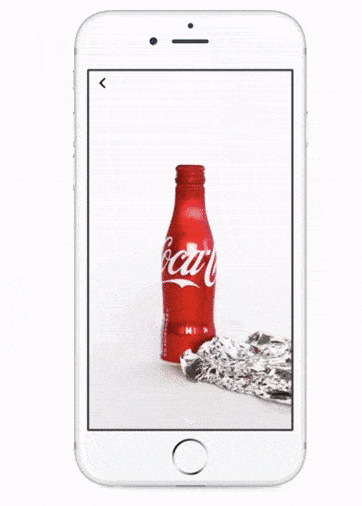Storytelling Coming to Life through Canvas
You cannot deny that phones have become our lifelines. If you’re a Facebook marketer (admit it, you most likely are if you end up reading our blog), you’ve probably experienced slow load times of your ads. Your biggest fear is that your customers close the window before the landing page has even loaded. This is where Facebook Canvas comes in, a quick loading ad feature that allows you to effectively attract prospects to your brand, bringing them closer towards conversion (the end of your marketing funnel). So, what’s Canvas about, what are the benefits and how are brands using Canvas? We will guide you through the story of Canvas.
What's Canvas
If you don’t know already, Canvas is a full-screen, mobile-optimised, post-click experience that can feature a combination of images, videos, text and links. It’s a storytelling feature that lets you showcase your products in a creative and immersive way, or as Neil Patel would say:
‘If you want to increase your conversions, then start captivating your target audience by speaking to their emotions.’
You can create a Canvas with the Canvas Builder in Power Editor or Ads Manager. When you finished creating your visually stunning storytelling experience, you will get a URL that you can use in website click and website conversion ads, mobile app ads, and photo/video page posts. Your customers can then zoom in on images, swipe through image carousels and even tilt their mobile device to view panoramic images. Your customers just have to click on your ad and will instantly trigger the full-screen Canvas, right within the Facebook app.
This is what it looks like in action

Benefits of Canvas
1 Loading data is faster
Time is money! Canvas was built for the mobile web, loading as much as 10 times faster than any external link would. Canvas ads are on Facebook, so users don’t have to leave the platform after they click. This reduces the risk of customers giving up because of the too slow loading time.
2 Your ads are customisable
One of the benefits of Canvas is how customisable it is. Because of this, there is no definitive way to create one. Even though Canvas is adaptable and flexible, it’s good to have thought through what sort of experience you want to create for people, and to have your creative assets ready ahead of time.
3 User engagement is higher
Canvas gives you an immersive way to reach your customers without making them leave the social network. Early Canvas tests have shown that users actually want to stick around and experience the ads. 53% of users that open a Canvas view at least half of it, and the average view time is a stunning 31 seconds.
When your customers click on your Canvas ad, it opens a full-screen, rich media page which engages your customers inside Facebook rather than forcing them to wait for a mobile website to load. Facebook Canvas allows interactive elements like animations, carousels, product catalogs, tilt-to-view images and videos. Canvas doesn’t frustrate users with long load times or tempt them to leave Facebook.
4 Re-engage with your customers
You can use your Canvas ads to create a funnel. Let’s say you created a Canvas ad to introduce a story, your brand, a solution or product. Those who open the Canvas get added to your Engagement Audience. You can then create another Canvas ad and re-target those who opened or clicked on your previous Canvas to take them further down the funnel. Canvas ads are really about keeping users engaged who show initial interest, even if they don’t immediately convert and buy your product. People opened your Canvas for a reason, so show them a different ad, taking a different angle and retarget those previously engaged audiences.
5 No coding needed
Great thing about Canvas ads is that they can look stunning without any help of professional designers or developers. The setup is pretty easy with a simple drag-and-drop method that does not need any coding.
How brands are using Facebook Canvas ads
1 Wendy's
Using interactive gifs and images, Wendy’s takes the customer through every ingredient in their famous burgers. There is a gif of cheese melting over a couple of burger patties and some animated ketchup.
‘The Wendy’s story carries a lot of equity with our fans and we wanted to invite them into that story, literally layer by layer. We are always looking for new ways to have fun with digital, and Facebook is a great partner in helping us do that.’ – Mike Bueno, Director of Digital Marketing Wendy

2 Coca Cola
Coca-cola used its first Canvas ad to announce the release of its new aluminum bottle. The shortest-lasting ad on this list, it showcases pictures of customers drinking from the new product and finishes with a short-time lapse of a mural dedicated to the new design.

3 American Express
American Express’ year-long brand campaign focused on their Blue Cash Everyday credit card. Partnering with Buzzfeed’s Tasty and Nifty, they showed how American Express could make everyday life more ‘epic’, and introduced their content through Facebook’s Canvas, making it more actionable and interactive for consumers.

4 Burberry
Through a virtual holiday gift lookbook, Burberry gave its fans a sneak peek at the new products and lines available for purchase during the holidays.

5 Ford
With the help of its agencies, Ford put people in the driving seat for this innovative campaign to promote its Ford VR app. Using the canvas format, the car company transported viewers to trackside pits and race car passenger seats for an awesome, immersive experience.

6 Citroen
Citroen launched a campaign for its colourful new electric car, E-Mehari. Using the Canvas format let Citroen tell a rich story spanning the origins of the car and its reinvention. Using image and video, the Canvas took viewers on a journey that led to a subscription form where they could apply for further information.

3 Takeaways for advertisers
1 Use the right creatives
Many pieces of creative go into creating a Canvas ad. If you don’t have time to craft one from scratch, you can easily repurpose elements from previous ad campaigns. If you analyse or A/B test your previous ads, you can ensure that the overall effect of the Canvas ad will be a hit. Make sure that each component you select promotes the same theme, product line or service so that the Canvas ad makes sense as a whole.
2 Don’t forget CTAs
Spreading calls-to-action (CTAs) throughout the Canvas ad makes it easy for your customers to take the next step in the conversion process at any point during their mobile browsing experience. Spreading your calls-to-action is especially useful for ensuring that your customers take the next step instead of dropping off before reaching a CTA button at the end of your Canvas ad.
3 Be creative
Don’t limit your Canvas ad to a passive viewing experience, but instead think of ways that will get your audience interested and involved. In the end, a customer that is interested enough to swipe all the way through your Canvas ad is likely willing to click through to your website, so put in that extra effort and make your ad extra creative.
Conclusion
Considering that mobile and video become increasingly dominant on the web, you should be looking for engaging new ways to tell your story to your customers. Facebook offers you these interactive, immersive storytelling ad formats basically for free, except for your Facebook advertising fees. With its detailed targeting options and free analytics, you basically have all the tools you need to push your ads to the next level. It’s just a matter of diving into this type of social advertising and getting started!
Subscribe to our Newsletter
Stay up to date via our monthly newsletter.



